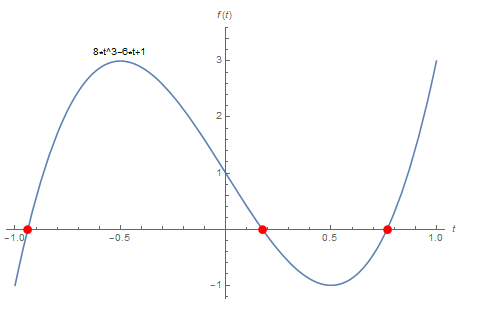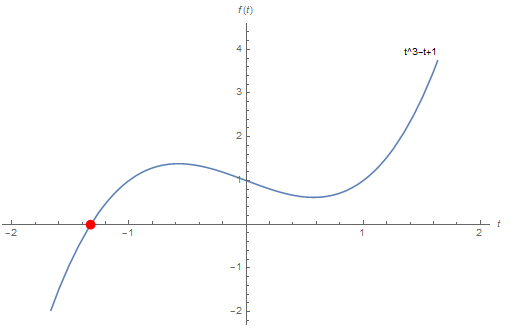Mathematica is a mathematical program that performs computations on complex numbers(complex plain) and therefore we see the imaginary unit I everywhere.
If You want solution try with ComplexExpand :
sol = Solve[8*t^3 - 6*t + 1 == 0, t] // ComplexExpand
(* {{t -> 1/2 Cos[\[Pi]/9] + 1/2 Sqrt[3] Sin[\[Pi]/9]}, {t ->
1/2 Cos[\[Pi]/9] - 1/2 Sqrt[3] Sin[\[Pi]/9]}, {t -> -Cos[\[Pi]/9]}} *)
sol//N
(* {{t -> 0.766044}, {t -> 0.173648}, {t -> -0.939693}} *)
Yours equation has 3 real roots:
Plot[8*t^3 - 6*t + 1, {t, -1, 1}, Epilog -> {Red, PointSize[0.02], Point[{t /. sol[[#]] // N, 0} & /@ {1, 2, 3}]},
AxesLabel -> {t, f[t]}, PlotLabels -> Placed[{"8*t^3-6*t+1"}, Above]]

Another example with 1 real and 2 complex roots:
sol1 = Solve[t^3 - t + 1 == 0, t] // ComplexExpand
(* {{t -> -(2/(3 (9 - Sqrt[69])))^(1/3) - (1/2 (9 - Sqrt[69]))^(1/3)/3^(
2/3)}, {t -> (1/2 (9 - Sqrt[69]))^(1/3)/(2 3^(2/3)) + 1/(
2^(2/3) (3 (9 - Sqrt[69]))^(1/3)) +
I (-(3^(1/6)/(2^(2/3) (9 - Sqrt[69])^(1/3))) + (9 - Sqrt[69])^(
1/3)/(2 2^(1/3) 3^(1/6)))}, {t -> (1/2 (9 - Sqrt[69]))^(1/3)/(
2 3^(2/3)) + 1/(2^(2/3) (3 (9 - Sqrt[69]))^(1/3)) +
I (3^(1/6)/(2^(2/3) (9 - Sqrt[69])^(1/3)) - (9 - Sqrt[69])^(1/3)/(
2 2^(1/3) 3^(1/6)))}}*)
sol1 // N
(* {{t -> -1.32472}, {t -> 0.662359 - 0.56228 I}, {t -> 0.662359 + 0.56228 I}} *)
Plot[t^3 - t + 1, {t, -2, 2}, Epilog -> {Red, PointSize[0.02],
Point[{t /. sol1[[#]] // N, 0} & /@ {1}]}, AxesLabel -> {t, f[t]}, PlotLabels -> Placed[{"t^3-t+1"}, Above]]
